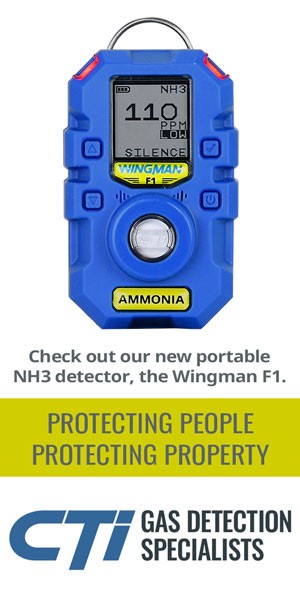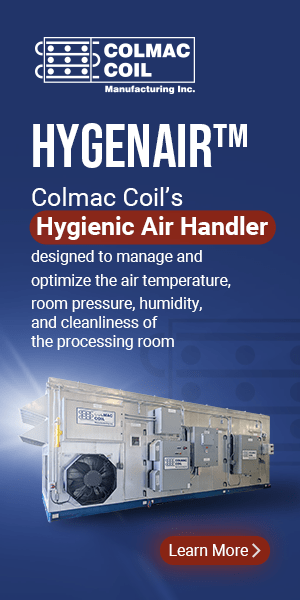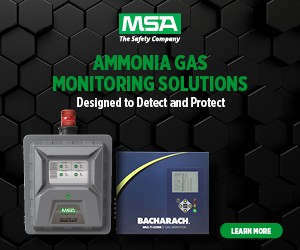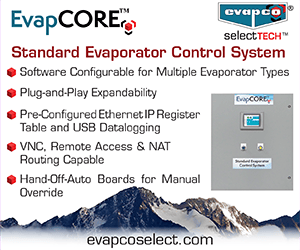Technical Papers and Workshops at a Glance
RAGAGEP: Historical Variants and the Importance of IIAR Standards
Recognized and Generally Accepted Good Engineering Practices (RAGAGEP) are written documents intended for use in the design, installation, operation, and maintenance of process equipment. There has been a move in the ammonia refrigeration industry towards standardization, yet there are historical variants which often cause confusion. This session will examine RAGAGEP variants and discuss the importance of adhering to IIAR standards. We’ll also look at tools for keeping RMP/PSM programs on-track and ensuring that a process adheres to RAGAGEP standards.Uriah Donaldson, Resource Compliance
Fallacies in Using P&IDs for Construction Drawings
Although P&IDs can be helpful in showing individual equipment components and operation, using them in place of system drawings can fall short in accurately conveying two-phase flow throughout an ammonia refrigeration system. And while P&IDs are shown in a two-dimensional drawing, two-phase flow requires a three-dimensional understanding of the movement of liquid and gas throughout a refrigeration system. This session is intended to show some of the common fallacies in using P&IDs to represent complete refrigeration piping systems, sometimes with catastrophic results.
Henry Bonar, PE, Bonar Engineering Inc.
Implementing Risk Based Inspections for the Ammonia Refrigeration Industry
OSHA’s PSM program and the EPA’s RMP rule rely on mechanical integrity to achieve the desired results. When it comes to mechanical integrity of piping and vessels, IIAR 6 allows facilities the option of either frequency-based or risk-based inspections. Making a transition from the IIAR B-110 frequency-based inspection program to a risk-based inspection protocol, however, requires a fair amount of planning and preparation. The transition from frequency to a risk-based inspection model requires some historical information be obtained first, but for many facilities this switch is a worthwhile effort.
Ric Hartung, Process & Safety Solutions LLC
Operating Experiences with Large Scale, Two-Stage, Three-Temperature, Ammonia DX Low-Temperature Refrigeration System
This session will describe the design, installation and operating experiences associated with a large scale, dual stage, three temperature, centralized low charge NH3 refrigeration plant. The total system design refrigeration capacity is approximately 1.7 MW (484 TR). Dry expansion refrigerant feed is employed throughout; there are no refrigerant pumps. We’ll touch on some of the design challenges encountered during the concept stage, and we’ll focus in detail on construction and commissioning experiences as well as recorded energy performances since May 2020.
Finn Dresen, Kältetechnik Dresen + Bremen, GmbH
The Case for HAZOP
Should hazard and operability (HAZOP) methodology be standard for Hazard Reviews (HRs) and Process Hazard Analyses (PHA)s. While there are advocates and opponents of the HAZOP methodology, this paper will argue that the benefits generally outweigh the costs. Opponents argue that HAZOP takes more time, and at a higher cost, than methodologies such as the What-If and/or Checklist methodologies. However, the additional effort yields a more exhaustive study identifying specific vulnerabilities throughout a potentially complex system. If the industry is aiming to enhance safety culture, shouldn’t it be embracing a deeper and more meaningful methodology to address vulnerabilities before failures occur?
Stephanie Smith, PE, Risk Management Professionals, Inc.
Sustainable Use Cases for Ammonia as a Refrigerant in Residential/Light-Commercial HVAC
Significant research and development has gone into the deployment of ammonia as a refrigerant in air-conditioning and heat pump systems, going back to the first half of the 20th century. This session will offer an overview of the basic thermodynamic cycles currently in application/development/consideration, as well as the accompanying hardware systems in various stages of maturation. We’ll also discuss the pros and cons of using this earliest of refrigerants that continues to provide some of the most promising performance – both in terms of all-round environmental impact and energy (resource) consumption.
Vikas Patnaik, PhD, MBA, PoleStar Consulting, LLC CFD
CFD Analysis of Pipework Fracture Due to Hydraulic Shock in an Ammonia Refrigeration System
Condensation induced hydraulic shock (CIHS) is a safety issue requiring accurate prediction of the risk of pipe rupture due to formation of a hydraulic shock. This session will describe a computerized fluid dynamics (CFD) that has been validated against experimental data. Its application to a real accident scenario produced accurate predictions and demonstrated capability to address safety and design issues in industrial scale refrigeration systems. We’ll also discuss the potential benefits of CFD analysis of generic valve group designs in locations where hydraulic shock most frequently occurs.
Chidambaram (Chidu) Narayanan, DSc, AFRY, AG; Lane Loyko, PLA Corp.; and Bent Wiencke, Nestle USA (retired)
Considerations in Designing Industrial Refrigeration Systems for Full Vacuum
This session will examine considerations regarding modes of test and operation that place ammonia refrigeration systems in a vacuum. We’ll present results for ASME BPVC calculations across a range of typical pressure vessels constructed from A516 carbon steel and show why full vacuum should not be applied to vessels that exceed a specified length to diameter ratio (L/D) unless the vessel nameplate indicates it has been designed for full vacuum.
Martin L. Timm, PE, CSP, Linde PLC (Retired)
Análisis de los ciclos de refrigeración con amoniaco/Analysis of Ammonia Refrigeration Cycles (delivered in Spanish)
Descripción de los ciclos aplicables de refrigeración con amoniaco de vapor por compresión para aplicaciones industriales con diferentes rangos de temperatura incluyendo procesos de ultra baja temperatura, baja temperatura, temperatura media y alta temperatura con explicación didáctica de aplicaciones de plantas frigoríficas con amoniaco para cubrir todas las necesidades industriales desde procesos de congelación, refrigeración hasta acondicionamiento de aire en fabricas de procesos de la industria de alimentos y otras donde se tengan necesidades de refrigeración en sus procesos de manufactura.
Silvio Toro, Froztec International, Inc.
Identifying and Quantifying Fugitive Emissions from Industrial Refrigeration Systems
Numerous facilities have experienced situations where a component in a refrigeration system intermittently leaks. Inherent in their intermittency is the difficulty of pinpointing the leak source. And when the source cannot be identified, continued refrigerant emission is the obvious result. This session will provide examples of fugitive emissions in industrial ammonia refrigeration systems and methods that can be used to locate and quantify the rate of loss.
Marc Claas, Industrial Refrigeration Consortium
Evaporadores para Areas de Procesamiento de Alimentos/Evaporators for Food Processing Areas (delivered in Spanish)
El control de patógenos en instalaciones de procesamiento de alimentos juega una parte importante en garantizarla seguridad de nuestros suministros de alimentos. Entre otros requerimientos, la USDA exige que el equipo sea limpiado cuidadosamente para remover manchas y después sanitizado para desinfectar las superficies. Con frecuencia estos dos procesos involucran químicos, los cuales, si no son seleccionados y aplicados adecuadamente, tienen el potencial de corroer y dañar las superficies de metal de los evaporadores. Este material discute las fuentes de corrosión, la resistencia a la corrosión de varios metales usados en evaporadores y hace recomendaciones de acuerdo con la selección de la construcción del serpentín y acompañamiento apropiado de desinfectantes y limpiadores químicos para el ambiente en operación.
Gabriel Gutierrez, Colmac Coil Manufacturing, Inc.
Válvulas Motorizadas. Cómo tomar ventaja completa?/Motorized Valves. How to Take Full Advantage? (delivered in Spanish)
Los ingenieros que pueden ser reacios a las nuevas tecnologías o componentes electrónicos y aquellos que no tienen el conocimiento suficiente sobre esta tecnología y sus beneficios, pueden obtener información detallada y soporte sobre las aplicaciones, características, consideraciones de cálculo y beneficios de las válvulas motorizadas para mejorar la forma en que diseñan y controlan sus sistemas de refrigeración industrial.
Roberto Badillo, Danfoss México
Procedimiento LOTO para Sistemas de Refrigeración/LOTO Procedure for Refrigeration Systems (delivered in Spanish)
Las energías peligrosas son la causa raíz de muchos accidentes laborales incapacitantes y fatales, este documento contiene información para controlar dichas energías través del procedimiento de bloqueo etiquetado (LOTO) para evitar accidentes. En este documento puede encontrar descripción de las energías peligrosas, procedimientos para realizar un bloqueo etiquetado sencillo o múltiple, actividades en las que se requiere el procedimiento, los tipos de dispositivo que se pueden usar en cada aplicación, pasos para retirar el dispositivo, para hacer cambios de turno laboral y las consecuencias de no cumplir estos requisitos.
Juan Carlos Zeledón, Cargill, Nicaragua
CO2 Aplicados en Centros de Distribución: caso de Éxito/CO2 Applied in Distribution Centers: A Case Study (delivered in Spanish)
A la hora de asegurar la calidad de los alimentos, es fundamental tener absoluto control en la cadena de frío. Los centros de distribución refrigerados son fundamentales en este aspecto, y su evolución tanto en su uso como en su ubicación hace que la tecnología de Refrigerante usado sea clave en su implementación. El uso de CO2 como refrigerante en los centros de distribución proporciona todas las ventajas desde el punto de vista de sustentabilidad, y a su vez permite construir centros logísticos flexibles, con una arquitectura que se adapta a lugares cerca a la población, multiambiente, con mejores proceso en conservación de alimentos, y aumento la calidad en sus procesos.
Mauricio Baena, Hillphoenix, Columbia
2021 Workshops
From Dry to Hybrid: A 360 Degree View of Cooling Technologies
A variety of fundamentally different dry cooling technologies are available for cooling water/glycol mixtures. The decision for or against one of these technologies during the planning stage of a project has an impact not only directly on the investment sum but also on the subsequent operating costs of the plant as a whole – across the entire life cycle. This is one of the reasons why it is important to know the applications of the technologies, as well as their specific advantages and disadvantages, and to evaluate them accordingly. Michael Freiherr and Miguel Garrido, Güntner, U.S.
Defrosting Finned Air Cooling Heat Exchangers – An Optimization Based on Practical Experiences and Theoretical Research
Typical methods for defrosting air coolers are by hot discharge gas, electrical heating rods, water or warm glycol. This session will discuss methods of controlling the defrost to avoid excessive steam formation from the defrost process. A control logic and strategy is presented to secure a safe, reliable and efficient defrost. The focus will be on hot gas, electrical and glycol defrost. The target is to present a best-practice for controlling the defrost. The second part will look at maximizing efficiency and reliability by preventing the escape of heat and moisture from the unit cooler. Felix Weber, thermofin GmBH
Determining Leak Rates in Ammonia Refrigeration Piping
Bent Wiencke, Nestle USA (retired)
2021 Panels
Panel 1: IIAR Research Panel
Information and discussion on current ARF funded IIAR research projects and results.
Panel 2: Code and Regulatory Panel
Updates from Code and Regulatory experts.












